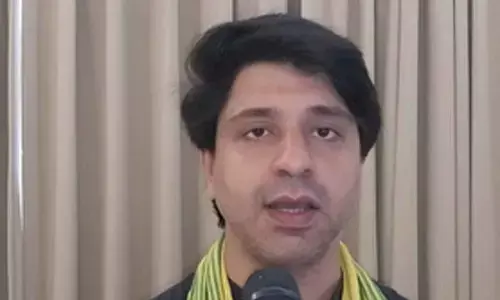Infra sector growth vital for development

As per latest data released in January 2016 on revised estimates of national income the growth of Industrial sector broadly comprising mining, manufacturing, electricity and construction is 5.9 per cent during 2014-15, as against a growth of 5.0 per cent during 2013-14. The advance estimates of national income 2015-16 shows that the growth of industrial sector is estimated to be 7.3 per cent with
Economic Survey stated that performance of manufacturing sector , industrial sector in India have registered higher growth during 2015-16. Many policy measures taken by the government for creating enabling environment for industrial growth have started showing its impact on increased FDI inflows, better performance of infrastructure sector.
The landmark initiatives like Make in India , Ease of doing Business, Start Up India, Digital India , and Smart Cities, etc. will provide further impetus to industries and the industrial sector is expected to be the key driver of economic growth in the country. These initiatives would also help in transforming infrastructure sector which is sine qua non for achieving and sustaining higher economic growth
According to the Survey, the year 2015-16 is witnessing a tumultuous global economic environment with major economics showing signs of slowdown in growth. It further states that against this background, the fact that the Indian economy has emerged as the fastest growing economy with a high growth rate of over 7 per cent. The manufacturing sector has been a major contributor in sustaining this high growth rate.
As per latest data released in January 2016 on revised estimates of national income the growth of Industrial sector broadly comprising mining, manufacturing, electricity and construction is 5.9 per cent during 2014-15, as against a growth of 5.0 per cent during 2013-14. The advance estimates of national income 2015-16 shows that the growth of industrial sector is estimated to be 7.3 per cent with manufacturing sector growing at 9.5 per cent.
Industrial Performance
As per IIP, the industrial sector broadly comprising mining, manufacturing and electricity attained 3.1 per cent growth during April- December 2015-16 as compared to 2.6 per cent during the same period of 2014-15 due to the higher growth in mining and manufacturing sector. The mining, manufacturing and electricity sectors grew by 2.3 per cent, 3.1 per cent, and 4.5 per cent respectively during April-December 2015-16, the Economic Survey observes.
MSME Sector
With 3.6 crore units spread across the country, that employ 8.05 crore people, Micro, Small and Medium Enterprises (MSME) have a contribution of 37.5 per cent to the country’s GDP. Realizing the important of the MSME sector, the Survey mention that the government has undertaken new initiatives like Udyog Aadhar Memorandum (UAM) scheme to promote ease of doing business for MSMEs, Employment Exchange for Industries for prospective job seekers and employers and Scheme for Promoting Innovation and Rural Entrepreneurs (ASPIRE) to promote start- ups for innovation and entrepreneurship in rural and agriculture- based industry.
Foreign Direct Investment (FDI)
Highlighting the role of Foreign direct investment (FDI) as an important driver of economic growth , the Survey states that the government has undertaken various reforms with a view to liberalizing and simplifying the FDI policy to provide ease of doing business climate in the country that will also lead to larger FDI inflows. More open FDI policy has been adopted with FDI allowed for Defence sector up to 49per cent; Railways 100per cent; Insurance and Pension 49per cent etc.
Apart from this, a number of sectors like construction, broadcasting, civil aviation, plantation, trading, private sector banking, satellite establishment and operation and credit information companies etc. have been liberalised. After the launch of the Make In India initiative in September 2014, there is a nearly 40 per cent increase in FDI inflows during October 2014- June 2015 over the corresponding period of the previous year.
The Survey further highlights that the various reforms in the FDI sector have led to a significant increase in FDI inflows into India. During April- November 2015, total FDI inflows were US$ 34.8 billion as compared to US$ 27.7 billion during April- November 2014, showing an increase of 26 per cent . FDI equity inflows also increased form US$ 18.9 billion during April- November 2014 to US$24.8 billion during April- November 2015, showing 31 per cent growth.
According the Economic Survey, the Government of India has taken a series of measures to improve Ease of doing Business in the country. Existing rules have been simplified and information technology introduced to make governance more efficient and effective. Reflecting the better economic performance and the commitment of the government to reforms, the global perception about India’s competitiveness has improved as per Global Competitiveness Index of the World Economic Forum. Significantly, at position 55, India went up 16 rungs in 2015-16, which is the largest gain among the major economies.
Performance of the Power Sector
In view of the growing need to the Indian economy, the Survey states that the government has embarked upon a massive programme to provide uninterrupted continuous access to power supply in the country. Several steps have been taken for increasing power generation, strengthening of transmission and distribution, separation of feeder and metering of power to consumers.
In order to restructure the sector, various amendments are being brought in the Electricity Act, and tariff policy in collaboration with states. During 2014-15, the achievement in electricity generation exceeded the target. Against the target of 1023 BU, the achievement was 1048.4 BU, registering y-o-y growth of 8.4 per cent. Annual generation crossed 1 trillion units last year. In the current year (April- December 2015), generation registered a growth of 4.4 per cent.
This is 97.6 per cent of the target of 849.9 BU during the year 2015-16 (April-December) .The survey further states that , as against the capacity addition target of 20037.1 MW set for 2015-16, 11,226 MW has been added till December 31, 2015. The cumulative capacity addition during the 12th Plan, as on December, 31, 2015, is 72,240 MW which constitutes 81.6 per cent of the plan target.
On distribution side, the Survey mentions several policy initiatives taken by the Government like Ujwal DISCOM Assurance Yojana (UDAY), Deen Dayal Upadhyaya Gram Jyoti Yojana (DDUGJY), Integrated Power Development Scheme (IPDS), Domestic Efficient Lighting Program (DELP), National Tariff Policy, 2016 and National Smart Grid Mission.
Performance of Coal Sector
The Economy Survey states that production of raw coal in India registered a growth of 4.7 per cent by producing 477.48 Mt during April – December 2015 as compared to the corresponding year to the previous year. The Annual target for coal production for 2015-16 have been fixed 700 Mt. The Survey further mentioned that due to higher domestic production, imports have been coming down since last year.
The Government has taken initiatives by enacting the Coal Mines (Special Provisions) Act 2015 to enable the government to reallocate 204 coal blocks whose allocations were cancelled by the Supreme Court. Under the Act, the Centre government has successfully auctioned 31 coal mines and allotted 42 coal mines/blocks to the central/state governments companies. Since the government has taken a number of policy initiatives, the Survey says that there have been notable turn around in the mining and quarrying sector.
The Government recently amended Mines and Minerals (Development and Regulation) Act 1957 for promoting the mining sector. A total of 35 mineral block have been offered by the seven states as on 31 December, 2015.
Petroleum sector
The Economy Survey mentioned improvements in Policy for production sharing contracts under NELP and testing requirements along with a Uniform Licensing and Open Acreage Policy etc. has been taken up. Regarding New & Renewable Energy Sector, the Survey observed that India is graduating from Magawatts to Gigawatts in generation of clean renewable energy.
The target from various renewable energy sources have been increased to 1.75 GW by the year 2022. The government has taken several initiatives like solar rooftop, solar parks, solar projects under the National Solar Mission (NSM), solar pumps, solar cities and Surya Mitra schemes have been launched.
Road sector
Concerning Road sector, the Survey mentioned that the government approved the scheme for the development of about 1177 kilometers of national highways and 4276 kilometers of state road in Left Wing Extremism affected areas as a special project with an estimated cost of about of Rs 7300 crore. Apart from this, Bharatmala Programme, an umbrella scheme is proposed at an estimated cost of 2,67, 200 crore. The programme is targeted for completion by 2022.
Telecommunications sector
Recognising the growth of telecommunications as one of the key drivers of socio-economic development, the Survey says the performance of the telecommunications sector during 2015-16 has been encouraging with approximately 33.4 million new telephone connection during April – October 2015. Overall Tele density in the country has been increased from 79.4 per cent as the beginning of the financial year to 81.5 per cent at the end of the October 2015. Under the Bharat Net Project 1,03, 643 Km of pipes and 79, 994 km of optical fibre cables (OFC) have been laid up to 30th November, 2015.
Urban infrastructure
To improve urban infrastructure, the government has taken various steps the government has launched a Mission of Smart Cities with the collaboration of states with UTs. The purpose of Smart Cities Mission is to drive the economic growth and improve the quality of life of people by enabling local area development and harassing technology.
The Mission will cover 100 cities which have been distributed among the state and UTs on the basis of equitable criteria. In addition to above, new initiatives like Swachh Bharat Mission, National Heritage City Development and Augmentation Yojana (HRIDAY), Atal Mission for Rejuvenation and Urban Transformation (AMRUT)
The Survey observes that Startup India is a flagship initiative of the Government of India to build a strong ecosystem for nurturing innovation, driving sustainable economic growth and generating large-scale employment opportunities. Apart from the technology sector the start-up movement will extend to a wide array of other sectors including agriculture, manufacturing, healthcare and education, and from existing tier 1 cities will extend to tier 2 and tier 3 cities including semi-urban and rural areas.
The Survey says that supply side bottlenecks, infrastructural and structural constraints hindering the achievement of medium-term growth and job creation, are being addressed on priority basis. Programmes like Make in India, Ease of Doing Business, Skill India, Startup India and reforms in various industrial and infrastructure sectors are some of the major initiatives in the direction of attracting more investment to ensure high industrial growth. Make in India and Ease of doing business in India are focusing on more and faster industrial growth while Startup India aims at nurturing an entrepreneurial mind set among youth in an in inclusive manner.
Woman injured in stabbing attack in Tokyo, suspect at large
Bengal cop booked for murder over mysterious death of woman home guard, SIT to probe case
Staffer recalls horror of 7-kg gold robbery by armed gang in Karnataka’s Hunsur
25-Year-Old Airline Cabin Crew Member Dies At Gurugram Party; Police Begin Investigation
















